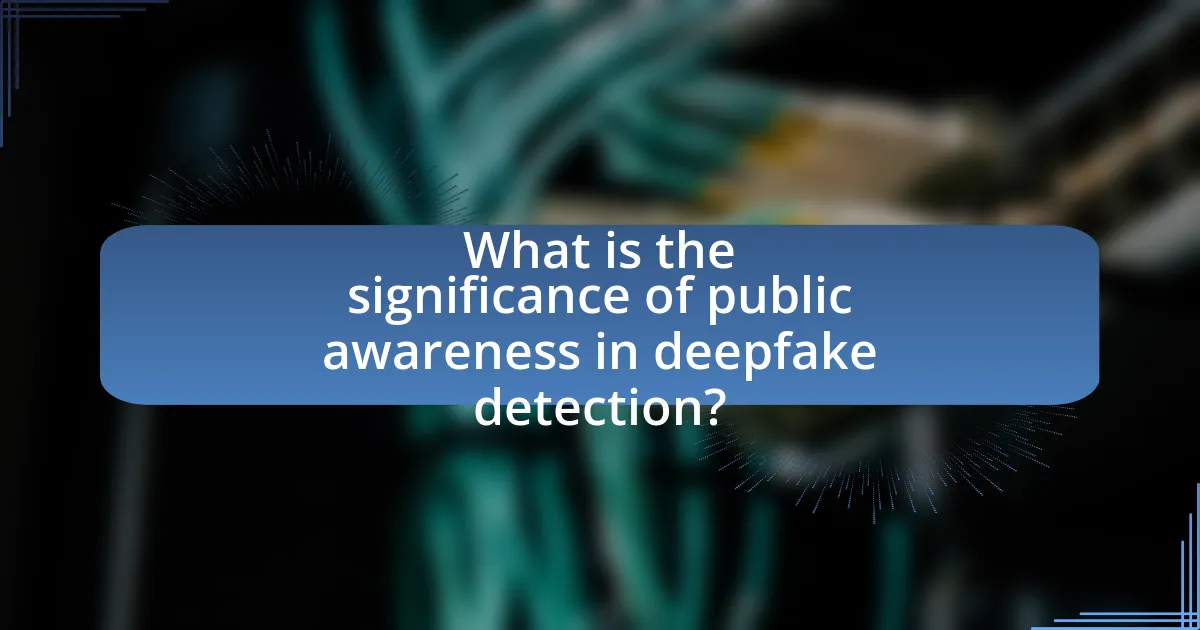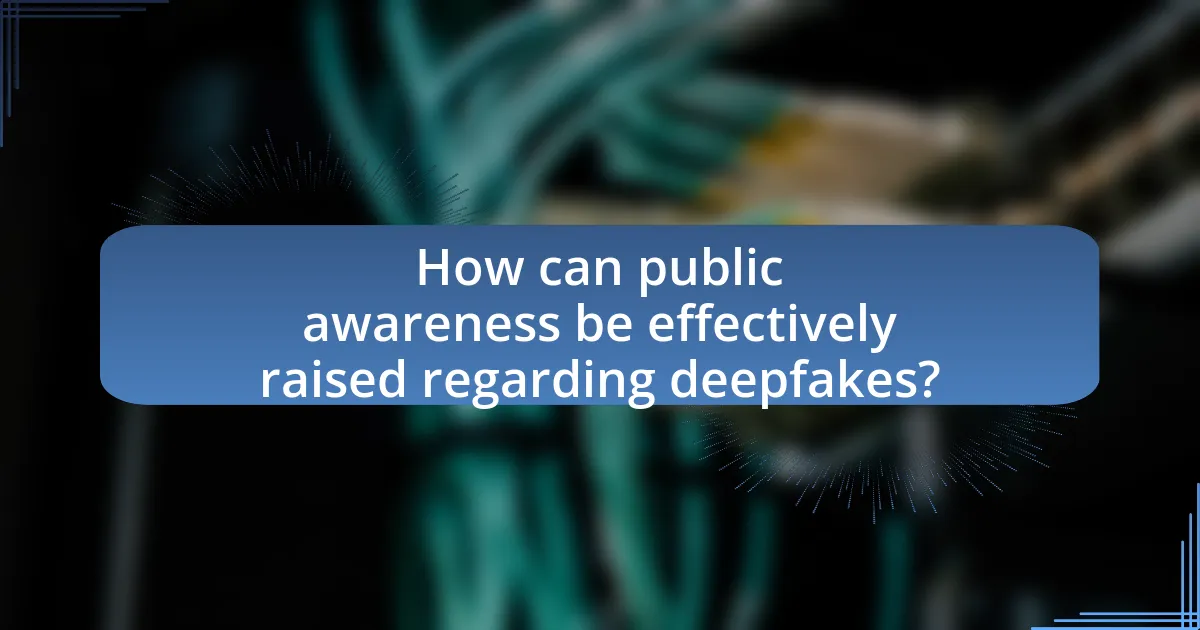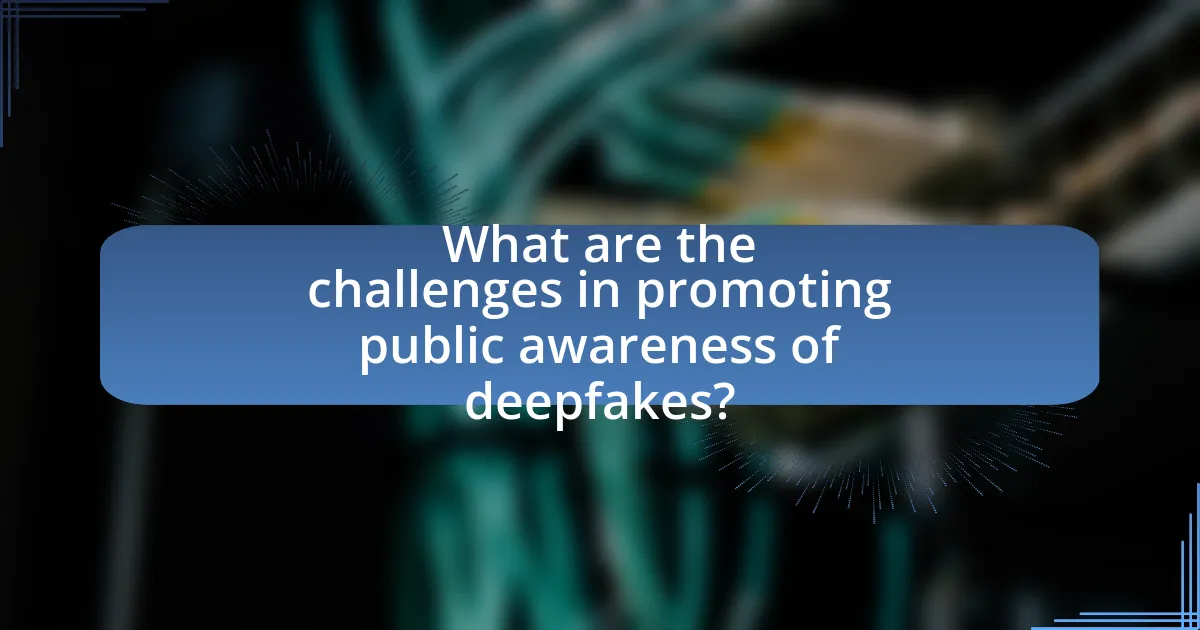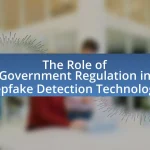The article focuses on the significance of public awareness in deepfake detection, emphasizing its role in empowering individuals to recognize and critically evaluate manipulated media. It discusses how increased awareness enhances media literacy, enabling the public to identify misinformation and reduce the impact of deepfakes on society. The article highlights the importance of education in fostering understanding of deepfake technology, the potential consequences of unawareness, and effective strategies for raising public awareness, including community engagement and collaboration with educational institutions. Additionally, it outlines practical steps individuals can take to verify media authenticity and protect themselves from misinformation.

What is the significance of public awareness in deepfake detection?
Public awareness is crucial in deepfake detection as it empowers individuals to recognize and critically assess manipulated media. Increased awareness leads to a more informed public that can identify potential misinformation, thereby reducing the impact of deepfakes on society. Studies indicate that when people are educated about the existence and characteristics of deepfakes, their ability to discern authentic content from manipulated media improves significantly. For instance, a survey by the Pew Research Center found that 86% of respondents believed that understanding deepfakes is essential for navigating online information effectively. This highlights the role of public awareness in fostering media literacy and promoting skepticism towards unverified content.
Why is public awareness crucial in combating deepfakes?
Public awareness is crucial in combating deepfakes because it empowers individuals to recognize and critically evaluate manipulated media. Increased awareness helps people identify the signs of deepfakes, such as inconsistencies in video quality or unnatural facial movements, which can prevent the spread of misinformation. Research from the Stanford Internet Observatory indicates that informed users are more likely to question the authenticity of suspicious content, thereby reducing the potential impact of deepfakes on public opinion and trust.
How does public awareness influence the perception of deepfakes?
Public awareness significantly influences the perception of deepfakes by shaping individuals’ understanding and skepticism towards manipulated media. When the public is informed about the existence and potential dangers of deepfakes, they are more likely to critically evaluate the authenticity of digital content. Research indicates that increased awareness leads to heightened scrutiny, as individuals become more adept at recognizing signs of manipulation. For instance, a study published in the journal “Computers in Human Behavior” found that participants who received education about deepfakes were better at identifying them compared to those who were not informed. This suggests that public awareness not only enhances detection skills but also fosters a general distrust of unverified media, ultimately influencing how deepfakes are perceived in society.
What role does education play in enhancing public awareness of deepfakes?
Education plays a crucial role in enhancing public awareness of deepfakes by providing individuals with the knowledge and skills necessary to identify and critically evaluate manipulated media. Through educational programs, workshops, and online resources, people learn about the technology behind deepfakes, the potential risks associated with them, and strategies for verification. Research indicates that informed individuals are more likely to recognize deepfake content; for instance, a study published in the journal “Computers in Human Behavior” found that participants who received training on media literacy were significantly better at detecting deepfakes compared to those who did not receive such training. This highlights the effectiveness of education in empowering the public to navigate the challenges posed by deepfake technology.
What are the potential consequences of a lack of public awareness?
A lack of public awareness regarding deepfakes can lead to significant consequences, including the spread of misinformation and erosion of trust in media. When individuals are unaware of deepfake technology, they may unknowingly share manipulated content, which can mislead public opinion and influence political or social outcomes. For instance, a study by the University of California, Berkeley, found that 70% of participants could not distinguish between real and deepfake videos, highlighting the risk of misinformation. Additionally, the inability to recognize deepfakes can result in reputational damage for individuals and organizations, as false narratives can quickly gain traction online.
How can misinformation spread due to unawareness of deepfakes?
Misinformation can spread due to unawareness of deepfakes because individuals may not recognize manipulated media as false, leading them to share it as credible information. This lack of awareness allows deepfakes to be disseminated widely across social media platforms, where users often prioritize speed over verification. Research indicates that 85% of people are unable to distinguish between real and deepfake videos, which exacerbates the issue by increasing the likelihood of sharing misleading content without scrutiny. Consequently, the unawareness of deepfakes contributes significantly to the proliferation of false narratives and misinformation in public discourse.
What risks do individuals face without knowledge of deepfake technology?
Individuals without knowledge of deepfake technology face significant risks, including the potential for misinformation, manipulation, and reputational harm. Misinformation can lead to individuals believing false narratives, as deepfakes can convincingly alter reality, making it difficult to discern truth from fabrication. Manipulation occurs when malicious actors use deepfakes to create misleading content for political or financial gain, which can mislead public opinion or defraud individuals. Reputational harm arises when individuals are depicted in compromising or false scenarios, leading to personal and professional consequences. According to a 2020 report by the Brookings Institution, 49% of Americans are unaware of deepfake technology, highlighting the vulnerability of the public to these risks.

How can public awareness be effectively raised regarding deepfakes?
Public awareness regarding deepfakes can be effectively raised through educational campaigns that inform individuals about the technology, its implications, and detection methods. These campaigns can utilize social media platforms, workshops, and community events to disseminate information, highlighting real-world examples of deepfakes and their potential consequences. Research indicates that 86% of people are unaware of deepfake technology, underscoring the need for targeted outreach to enhance understanding and vigilance. By incorporating interactive elements, such as demonstrations of deepfake detection tools, these initiatives can engage the public and foster critical thinking about media authenticity.
What strategies can be employed to educate the public about deepfakes?
To educate the public about deepfakes, strategies such as public awareness campaigns, educational workshops, and collaboration with social media platforms can be employed. Public awareness campaigns can utilize various media channels to disseminate information about the nature of deepfakes, their potential risks, and how to identify them. Educational workshops can be organized in schools, community centers, and online platforms to provide hands-on training on recognizing deepfake technology and its implications. Collaboration with social media platforms is crucial, as these platforms can implement features that flag or label deepfake content, thereby informing users about the authenticity of the media they encounter. Research indicates that increased public awareness can significantly reduce the impact of misinformation, as seen in studies conducted by the Pew Research Center, which found that informed individuals are more likely to critically evaluate the content they consume.
How can social media campaigns contribute to public awareness?
Social media campaigns can significantly enhance public awareness by disseminating information rapidly and engaging a wide audience. These campaigns utilize platforms like Facebook, Twitter, and Instagram to share educational content, real-time updates, and interactive discussions about deepfake technology and its implications. For instance, a study by the Pew Research Center found that 69% of adults in the U.S. use social media, making it a powerful tool for reaching diverse demographics. By leveraging hashtags, viral content, and influencer partnerships, social media campaigns can effectively inform the public about the risks associated with deepfakes, thereby fostering critical thinking and vigilance.
What role do educational institutions play in raising awareness?
Educational institutions play a crucial role in raising awareness about deepfake technology and its implications. They provide structured education and resources that inform students and the public about the risks associated with deepfakes, including misinformation and identity theft. For instance, universities often incorporate digital literacy programs into their curricula, which teach students how to critically evaluate online content. Research by the Pew Research Center indicates that educational initiatives significantly enhance individuals’ ability to discern credible information from manipulated media. By fostering critical thinking and media literacy, educational institutions empower individuals to recognize and respond to the challenges posed by deepfake technology.
What resources are available for individuals to learn about deepfakes?
Individuals can learn about deepfakes through various resources, including online courses, academic papers, and dedicated websites. Online platforms like Coursera and edX offer courses on artificial intelligence and media literacy that cover deepfake technology. Academic papers, such as “Deepfakes: A New Threat to Privacy and Security” published in the Journal of Cybersecurity, provide in-depth analysis and research findings. Additionally, websites like Deepfakes Detection Challenge and the Deepfake Detection Toolkit offer tools and information for understanding and identifying deepfakes. These resources collectively enhance public awareness and understanding of deepfake technology and its implications.
Which organizations provide information and training on deepfake detection?
Organizations that provide information and training on deepfake detection include the Digital Forensics Research Workshop (DFRWS), the Berkman Klein Center for Internet & Society at Harvard University, and the Partnership on AI. DFRWS focuses on advancing the field of digital forensics, including deepfake detection, through workshops and publications. The Berkman Klein Center conducts research and offers resources on the implications of deepfakes, while the Partnership on AI collaborates with various stakeholders to promote best practices and awareness regarding AI technologies, including deepfakes. These organizations contribute to enhancing public understanding and technical skills necessary for identifying and mitigating the risks associated with deepfakes.
How can online platforms facilitate awareness and education on deepfakes?
Online platforms can facilitate awareness and education on deepfakes by implementing educational resources, interactive tools, and community engagement initiatives. These platforms can provide informative articles, videos, and tutorials that explain what deepfakes are, how they are created, and their potential impacts on society. For instance, platforms like YouTube and social media sites can host content from experts in digital media and cybersecurity to raise awareness. Additionally, interactive tools that allow users to identify deepfakes can enhance understanding and recognition skills. Research indicates that educational interventions significantly improve users’ ability to detect manipulated media, as shown in a study published in the journal “Computers in Human Behavior,” which found that participants who received training on deepfake detection improved their accuracy by over 30%. By combining these strategies, online platforms can effectively contribute to public awareness and education regarding deepfakes.

What are the challenges in promoting public awareness of deepfakes?
Promoting public awareness of deepfakes faces several challenges, primarily due to the rapid evolution of technology and the complexity of the issue. One significant challenge is the lack of understanding among the general public regarding what deepfakes are and how they can be created, which leads to skepticism about their prevalence and impact. According to a 2020 study by the Pew Research Center, 51% of Americans reported being unaware of deepfake technology, highlighting the knowledge gap that hampers awareness efforts. Additionally, the sophistication of deepfake creation tools makes it difficult for individuals to discern between real and manipulated content, further complicating educational initiatives. Misinformation and sensationalism in media coverage can also distort public perception, making it harder to convey accurate information about the risks associated with deepfakes. These factors collectively hinder effective communication strategies aimed at raising awareness and fostering critical thinking among the public.
What obstacles do educators face in teaching about deepfakes?
Educators face several obstacles in teaching about deepfakes, primarily including a lack of resources, insufficient training, and the rapid evolution of technology. The lack of resources, such as updated curriculum materials and access to technology, hinders effective instruction. Insufficient training for educators on the technical aspects and implications of deepfakes limits their ability to convey the subject accurately. Additionally, the rapid evolution of deepfake technology creates challenges in keeping educational content relevant, as new techniques and tools emerge frequently. These factors collectively impede educators’ efforts to raise public awareness about deepfake detection.
How does the rapid evolution of technology complicate awareness efforts?
The rapid evolution of technology complicates awareness efforts by continuously introducing new tools and methods that can outpace public understanding and education. For instance, advancements in artificial intelligence and machine learning have led to increasingly sophisticated deepfake technologies, making it difficult for individuals to discern real from manipulated content. A study by the Stanford University Internet Observatory found that as deepfake technology improves, the potential for misinformation increases, highlighting the urgent need for public awareness initiatives to keep pace with these developments.
What misconceptions about deepfakes hinder public understanding?
Misconceptions about deepfakes that hinder public understanding include the belief that all deepfakes are highly realistic and indistinguishable from real videos. This misconception leads to an underestimation of the varying quality of deepfakes, as many are easily identifiable due to artifacts or inconsistencies. Additionally, the assumption that deepfakes are solely used for malicious purposes overlooks their potential for legitimate applications in entertainment and education. Research from the Stanford Internet Observatory highlights that while deepfakes can be harmful, they also have creative uses, which is often ignored in public discourse. Furthermore, the idea that deepfakes are a new phenomenon disregards the historical context of manipulated media, which has existed for decades, thus complicating the public’s understanding of their implications.
How can collaboration enhance public awareness initiatives?
Collaboration can enhance public awareness initiatives by pooling resources, expertise, and networks to amplify messaging and reach a broader audience. When organizations, governments, and communities work together, they can create more comprehensive campaigns that address the complexities of issues like deepfake detection. For instance, a study by the Pew Research Center found that collaborative efforts in public health campaigns significantly increased engagement and understanding among diverse populations. This collective approach not only improves the quality of information disseminated but also fosters trust and credibility, essential for effective awareness in combating misinformation.
What partnerships can be formed between tech companies and educational institutions?
Tech companies and educational institutions can form partnerships focused on research collaboration, curriculum development, and technology integration. Research collaboration allows both entities to work together on projects that advance knowledge in areas like artificial intelligence and deepfake detection, leveraging the expertise of tech companies and the academic rigor of educational institutions. Curriculum development partnerships enable tech companies to provide resources, tools, and real-world insights that enhance educational programs, ensuring students are equipped with relevant skills. Additionally, technology integration partnerships can facilitate the implementation of cutting-edge tools and platforms in classrooms, fostering an environment conducive to learning about emerging technologies such as deepfake detection. These partnerships are increasingly important as they bridge the gap between theoretical knowledge and practical application, preparing students for future challenges in technology.
How can community organizations contribute to awareness campaigns?
Community organizations can significantly contribute to awareness campaigns by leveraging their local networks to disseminate information effectively. These organizations often have established trust within their communities, enabling them to engage residents through workshops, social media outreach, and informational materials tailored to specific demographics. For instance, a study by the Pew Research Center indicates that community-based initiatives can increase public understanding of complex issues, such as deepfake technology, by 30% when compared to traditional media campaigns. By utilizing their resources and connections, community organizations can enhance the reach and impact of awareness campaigns, ensuring that critical information about deepfake detection is accessible and comprehensible to a broader audience.
What practical steps can individuals take to stay informed about deepfakes?
Individuals can stay informed about deepfakes by regularly following credible news sources and technology blogs that cover advancements in artificial intelligence and media manipulation. Engaging with educational platforms that offer courses or webinars on digital literacy and media verification can enhance understanding of deepfake technology. Additionally, subscribing to newsletters from organizations focused on digital ethics, such as the Digital Civil Society Lab, provides updates on the latest research and developments. Participating in community discussions or forums dedicated to misinformation and digital media can also foster awareness and critical thinking regarding deepfakes.
How can individuals verify the authenticity of media they encounter?
Individuals can verify the authenticity of media by cross-referencing information with credible sources and utilizing fact-checking tools. This process involves checking the original source of the media, analyzing metadata, and employing reverse image searches to trace the origin of images or videos. For instance, platforms like Snopes and FactCheck.org provide resources to validate claims and debunk misinformation. Additionally, tools such as InVID can help analyze videos for signs of manipulation. Research indicates that public awareness and education on these verification methods significantly enhance the ability to detect deepfakes and misinformation, as highlighted in studies by the Pew Research Center, which found that informed individuals are more adept at identifying false media.
What best practices should individuals follow to protect themselves from deepfakes?
Individuals should verify the authenticity of videos and images before sharing them to protect themselves from deepfakes. This can be achieved by cross-referencing content with trusted news sources or using reverse image search tools to check the origin of the media. Research indicates that misinformation spreads rapidly, with a study from MIT showing that false news stories are 70% more likely to be retweeted than true stories. Additionally, individuals should be cautious of content that elicits strong emotional reactions, as deepfakes often aim to manipulate viewers’ feelings. By maintaining a critical mindset and employing verification techniques, individuals can significantly reduce the risk of being misled by deepfakes.


